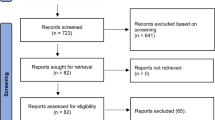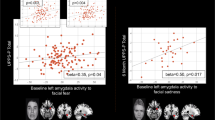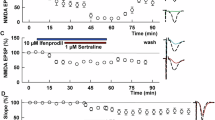Abstract
To test the hypothesis that traits of aggression and impulsivity correlate negatively with central serotonergic system function in a nonpatient population, a standard fenfluramine challenge (for assessment of serotonergic responsivity) and behavioral measurements germane to aggression/impulsivity were administered to a community-derived sample of 119 men and women. In men, peak prolactin responses to fenfluramine correlated significantly with an interview-assessed life history of aggression (r = −.40, p < .002), the Barratt Impulsiveness Scale (r = −.30, p < .03), and traits of Conscientiousness (r = +.30, p < .03), Neuroticism (r = −.31, p < .02) and Angry Hostility (r = −.35, p < .01) on the NEO-Personality Inventory. No significant relationships were observed across all women, although subanalyses restricted to postmenopausal subjects (in whom ovarian influences on prolactin secretion may be mitigated because of diminished estrogen) showed a pattern of behavioral associations somewhat similar to that seen in men. By extending documented relationships between an index of central serotonergic system function and traits of aggression and impulsivity to a more normative range of population variability than is represented in prior literature, this study supports speculation that these associations reflect a basic neurobehavioral dimension of individual differences.
Similar content being viewed by others
Log in or create a free account to read this content
Gain free access to this article, as well as selected content from this journal and more on nature.com
or
References
Barratt ES . (1985): Impulsiveness subtraits: Arousal and information processing. Spence JT, Izard CE (eds), motivation, emotion and personality. Elsevier Science Amsterdam, Inc., pp 137–146
Barratt ES . (1994): Impulsiveness and aggression. In Monahan J, Steadman HJ (eds), Violence and mental disorder: Developments in risk. Chicago, University of Chicago Press, pp 61–79
Ben-Jonathan N . (1985): Dopamine: A prolactin-inhibiting hormone. Endocrinol Rev 6: 564–589
Bendig AW . (1962): Factor analytic scales of covert and overt hostility. J Consult Psychology 26: 200–206
Biaggio MK, Supplee K, Curtis N . (1981): Reliability and validity of four anger scales. J Personality Psychology 45: 639–648
Biegon A, Fischette CT, Rainbow TC, McEwen BS . (1982): Serotonin receptor modulation by estrogen in discrete brain nuclei. Neuroendocrinol 35: 287–291
Borroni E, Ceci A, Garattini S, Mennini T . (1983): Differences between d-fenfluramine and d-norfenfluramine in serotonin presynaptic mechanisms. J Neurochemistry 40: 891–893
Botchin MB, Kaplan JR, Manuck SB, Mann JJ . (1993): Low versus high prolactin responders to fenfluramine challenge: Marker of behavioral differences in adult male cynomolgus macaques. Neuropsychopharmacology 9: 93–99
Bouchard TJ . (1994): Genes, environment, and personality. Science 264: 1700–1701
Brown GL, Goodwin FK, Ballenger JC, Goyer PF, Major LF . (1979): Aggression in humans correlates with cerebrospinal fluid amine metabolites. Psychiatry Res 1: 131–139
Brown GL, Ebert MH, Goyer PF, Jimerson DC, Klein WJ, Bunney WE, Goodwin FK . (1982): Aggression, suicide, and serotonin: Relationships to CSF amine metabolites. Am J Psychiatry 139: 741–746
Buss AH, Durkee A . (1957): An inventory for assessing different kinds of hostility. J Consult Psychol 21: 343–348
Buss AH, Plomin R . (1984): Temperament: Early Developing Personality Traits Hillsdale, NJ, Lawrance Erlbaum Associates
Cleare AJ, Bond AJ . (1997): Does central serotonergic function correlate inversely with aggression? A study using d-fenfluramine in healthy subjects. Psychiatry Res 69: 89–95
Cloninger CR . (1987): A systematic method for clinical description and classification of personality variants. Arch Gen Psychiatry 44: 573–588
Coccaro EF . (1992): Impulsive aggression and central serotonergic system function in humans: An example of a dimensional brain-behavior relationship. Int Clin Psychopharmacol 7: 3–12
Coccaro EF, Bergeman CS, McClearn GE . (1993): Heritability of irritable impulsiveness: A study of twins reared together and apart. Psychiatry Res 48: 229–242
Coccaro EF, Gabriel S, Siever LJ . (1990): Buspirone challenge: Preliminary evidence for a role for central 5-HT1a receptor function in impulsive aggressive behavior in humans. Psychopharmacol Bull 26: 393–405
Coccaro EF, Kavoussi RJ, Cooper TB, Hauger RL . (1996a): Hormonal responses to d- and d,I-fenfluramine in healthy human subjects. Neuropsychopharmacology 15: 595–607
Coccaro EF, Kavoussi RJ, Cooper TB, Hauger RL . (1997): Central serotonin activity and aggression: Inverse relationship with prolactin response to d-fenfluramine, but not CSF 5-HIAA concentration, in human subjects. Am J Pschiatry 154: 1430–1435
Coccaro EF, Kavoussi RJ, Hauger RL . (1995): Physiological responses to d-fenfluramine and ipsapirone challenge correlate with indices of aggression in males with personality disorders. Int Clin Psychopharmacol 10: 177–179
Coccaro EF, Kavoussi RJ, Sheline YI, Lish JD, Csernansky JF . (1996b): Impulsive aggression in personality disorder correlates with tritiated paroxetine binding in the platelet. Arch Gen Psychiat 53: 531–536
Coccaro EF, Klar H, Siever LJ . (1994a): Reduced prolactin response to fenfluramine challenge in personality disorder patients is not due to deficiency of pituitary lactotrophs. Biol Psychiatry 36: 344–346
Coccaro EJ, Siever LJ, Klar HM, Maurer G, Cochrane K, Cooper TB, Mohs RC, Davis KL . (1989): Serotonergic studies in patients with affective and personality disorders. Arch Gen Psychiatry 46: 587–599
Coccaro EF, Silverman JM, Klar HM, Horvath TB, Siever LJ . (1994b): Familial correlates of reduced serotonergic system function in patients with personality disorders. Arch Gen Pscyhiatry 51: 318–324
Costa PT, McCrae RR . (1992): Revised NEO Personality Inventory (NEO PI-R) and NEO Five-Factor Inventory (NEO-FFI): Professional Manual Odessa, FL, Psychological Assessment Resources Inc.
Depue RA, Spoont MR . (1986): Conceptualizing a serotonin trait: A behavioral dimension of constraint. Ann NY Acad Sci 487: 47–62
DiRenzo G, Amoroso S, Taglialatela M, Canzoniero L, Basile V, Fatatis A, Annunziato L . (1989): Pharmatological characterization of serotonin receptors involved in the control of prolactin secretion. Eur J Pharmacol 162: 371–373
Elin RJ . (1992): Reference intervals and laboratory values of clinical importance. In Wyngaarder JB, Smith LH, Bennett JC (eds), Cecil Textbook of Medicine, 19th ed. Philadelphia, WB Saunders Co., pp 2370–2380
Fishbein DH, Lozovsky D, Jaffe JH . (1989): Impulsivity, aggression, and neuroendocrine responses to serotonergic stimulation in substance abusers. Biol Psychiatry 25: 1049–1066
Fontenot MB, Kaplan JR, Manuck SB, Arango V, Mann JJ . (1995): Long-term effects of chronic social stress on serotonergic indices in the prefrontal cortex of adult male cynomolgus macaques. Brain Res 705: 105–108
Goodall EM, Cowen PJ, Franklin M, Silverstone T . (1993): Ritanserin attenuates anorectic, endocrine and thermic responses to d-fenfluramine in human volunteers. Psychopharmacology 112: 461–466
Garattini S, Bizzi Z, Caccia S, Mennini T, Samanin R . (1988): Progress in assessing the role of serotonin in the control of food intake. Clin Neuropharmacology 11: S8–S32
Gray JA . (1987): The neuropsychology of emotion and personality. In Stahl SM, Iverson SD, Goodman EC (eds), Cognitive neurochemistry. Oxford, UK, Oxford University Press, pp 171–190
Higley JD, King ST, Hasert MJ, Champoux M, Suomi SJ, Linnoila M . (1996a): Stability of interindividual differences in serotonin function and its relationship to severe aggression and competent social behavior in rhesus macaque females. Neuropsychopharmacology 14: 67–76
Higley JD, Mehlman PT, Higley SB, Fernald B, Vickers J, Lindell SG, Taub DM, Suomi SJ, Linnoila M . (1996b): Excessive mortality in young free-ranging male nonhuman primates with low cerebrospinal fluid 5-hydroxyindoleacetic acid concentrations. Arch Gen Psychiatry 53: 537–542
Higley JD, Mehlman PT, Taub DM, Higley PB, Suomi SF, Linnoila M, Vickers JH . (1992): Cerebrospinal fluid monoamine and adrenal correlates of aggression in free-ranging rhesus monkeys. Arch Gen Psychiatry 49: 436–441
Higley JD, Suomi SJ, Linnoila M . (1991): CSF monoamine metabolite concentrations vary according to age, rearing, and sex, and are influenced by the stressor of social separation in rhesus monkeys. Psychopharmacology 103: 551–556
Higley JD, Thompson WW, Champoux M, Goldman D, Hasert MF, Draemer G-W, Scanlan JM, Suomi SJ, Linnoila M . (1993): Paternal and maternal genetic and environmental contributions to cerebrospinal fluid monoam-ine metabolites in rhesus monkeys (Macaca mullata). Arch Gen Psychiatry 50: 615–623
Kaplan JR, Fontenot MB, Berard J, Manuck SB, Mann JJ . (1995): Delayed dispersal and elevated monoaminergic activity in free-ranging rhesus monkeys. Am J Primatology 35: 229–234
Kessler RC, McGonagle KA, Zhao S, Nelson CB, Hughes M, Eshleman S, Wittchen H, Kendler KS . (1994): Lifetime and 12-month prevalence of DSM-III-R psychiatric disorders in the United States. Arch Gen Psychiatry 51: 8–19
Kirk RE . (1968): Experimental design: Procedures for the behavioral sciences Belmont, CA, Wadsworth Publishing Co.
Kruesi MJP, Hibbs ED, Zahn TP, Keysor CS, Hamburger SD, Bartko JJ, Rapoport JL . (1992): A 2-year prospective follow-up study of children and adolescents with disruptive behavior disorders. Arch Gen Psychiatry 49: 429–435
Kruesi MJP, Rapoport JL, Hamburger S, Hibbs E, Potter WZ, Lenane M, Brown GL . (1990): Cerebrospinal fluid monoamine metabolites, aggression, and impulsivity in disruptive behavior disorders of children and adolescents. Arch Gen Psychiatry 47: 419–426
Lenzenweger MF, Loranger AW, Korfine L, Neff C . (1997): Detecting personality disorders in a nonclinical population. Arch Gen Psychiatry 54: 345–351
Lesch K-P, Bengel D, Heils A, Sabol SZ, Greenberg BD, Petri S, Benjamin J, Muller CR, Hamer DH, Murphy DL . (1996): Association of anxiety-related traits with a polymorphism in the serotonin transporter gene regulatory region. Science 274: 1527–1531
Lewis DA, Sherman BM . (1985): Serotonergic regulation of prolactin and growth hormone secretion in man. Acta Endocrinol 110: 152–157
Liebenluft E, Fiero PL, Rubinow DR . (1994): Effects of the menstrual cycle on dependent variables in mood disorder research. Arch Gen Psychiatry 51: 761–781
Limson R, Goldman D, Roy A, Lamparski D, Ravitz B, Adinoff B, Linnoila M . (1991): Personality and cerebrospinal fluid monoamine metabolites in alcoholics and controls. Arch Gen Psychiatry 48: 437–441
Linnoila M, Virkkunen M, Scheinin M, Nuutila A, Pimon R, Goodwin FK . (1983): Low cerebrospinal fluid 5-hydroxyindoleacetic acid concentration differentiates impulsive from nonimpulsive violent behavior. Life Sci 33: 2609–2614
Luengo MA, Carrillo-de-la-Pena MT, Otero JM, Romero E . (1994): A short-term longitudinal study of impulsivity and antisocial behavior. J Personality Social Psychol 66: 542–548
Lyons MJ . (1995): Epidemiology of personality disorders. In Tsuang MT, Tohen M, Zahner GEP (eds), Textbood in psychiatric epidemiology. New York, Wiley-Liss, pp 407–502
McBride PA, Tierney H, DeMeo M, Chen J-S, Mann JJ . (1990): Effects of age and gender on CNS serotonergic responsivity in normal adults. Biol Psychiatry 27: 1143–1155
McKittrick CR, Glanchard DC, Blanchard RJ, McEwen BS, Sakai RR . (1995): Serotonin receptor binding in a colony model of chronic social stress. Biol Psychiatry 37: 383–393
Mehlman PT, Higley JD, Faucher I, Lilly AA, Taub DM, Vickers J, Suomi SJ, Linnoila M . (1994): Low CSF 5-HIAA concentrations and severe aggression and impaired impulse control in nonhuman primates. Am J Psychiatry 151: 1485–1491
Mehlman PT, Higley JD, Faucher I, Lilly AA, Taub DM, Vickers J, Suomi SJ, Linnoila M . (1995): Correlation of CSF 5-HIAA concentration with sociality and the timing of emigration in free-ranging primates. Am J Psychiatry 152: 907–913
Meltzer HY, Arora RC . (1988): Genetic control of serotonin uptake in blood platelets: A twin study. Psychiatry Res 24: 263–269
Moeller FG, Steinberg JL, Petty F, Fulton M, Cherek DR, Dramer G, Garver DL . (1994): Serotonin and impulsive/aggressive behavior in cocaine dependent subjects. Prog Neuro-Psychopharmacol & Biol Psychiat 18: 1027–1035
Moss HB, Yao JK, Panzak GL . (1990): Serotonergic responsivity and behavioral dimensions in antisocial personality disorder with substance abuse. Biol Psychiatry 28: 325–338
Muldoon MF, Manuck SB, Jansma CL, Moore AL, Perel J, Mann JJ . (1996): d,I-fenfluramine challenge test: Experience in nonpatient sample. Biol Psychiatry 39: 761–768
O'Keane V, O'Hanlon M, Webb M, Dinan T . (1991): d-Fenfluramine/prolactin response throughout the menstrual cycle: Evidence for an oestrogen-induced alteration. Clin Endocrinol 34: 289–292
O'Keane VO, Moloney E, O'Neill H, O'Connor A, Smith R, Dinan TG . (1992): Blunted prolactin responses to d-Fenfluramine in sociopathy: Evidence for subsensitivity of central serotonergic function. Br J Psychiatry 160: 643–646
Oxenstierna G, Edman G, Iselius L, Oreland L, Ross SB, Sedvall G . (1976): Concentrations of monamine metabolites in the cerebrospinal fluid of twins and unrelated individuals: A genetic study. J Psychiat Res 20: 19–29
Patton JH, Stanford MS, Barratt ES . (1995): Factor structure of the Barratt Impulsiveness Scale. J Clin Psychol 51: 768–774
Plomin R, Daniels D . (1987): Why are children in the same family so different from one another?. Behav Brain Sci 10: 1–60
Quattrone A, Schettini G, Dirienzo GF, Tedeshi G, Preziosi P . (1979): Effect of midbrain raphe lesion or 5,7-dihydroxytryptamine treatments on the prolactin-releasing action of quipazine and d-fenfluramine in rats. Brain Res 174: 71–79
Quattrone A, Tedeschi G, Aguglia U, Scopacasa F, DiRenzo GF, Annunziato L . (1983): Prolactin secretion in man, a useful tool to evaluate the activity of drugs on central 5-hydroxytryptaminergic neurons: Studies with fenfluramine. Br J Pharmacol 16: 471–475
Reich J, Yates W, Nduaguba M . (1989): Prevalence of DSM-III personality disorders in the community. Soc Psychiatry Psychiatr Epidemiol 24: 12–16
Roy A, Adinoff B, Linnoila M . (1988): Acting out hostility in normal volunteers: Negative correlation with levels of 5HIAA in cerebrospinal fluid. Psychiatry Res 24: 187–194
Rydin E, Schallin D, Asberg M . (1982): Rorschach ratings in depressed and suicidal patients with low levels of 5-hydroxyindoleacetic acid in cerebrospinal fluid. Psychiatry Res 7: 229–243
Samuels JF, Nestadt G, Romanoski AJ, Folstein M, McHugh PR . (1994): DSM-III personality disorders in the community. Am J Psychiatry 151: 1055–1062
Soubrie P . (1986): Reconciling the role of central serotonin neurons in humans and animal behavior. Behav Brain Sci 9: 319–364
Spitzer RL, Williams JBW, Gibbon M, First MB . (1990): Structured Clinical Interview for DSM-II-R: Non-patient edition (SCID-NP, Version 1.0) Washington, DC, American Psychiatric Press
Stoff DM, Pasatiempo AP, Yeung J, Cooper TB, Bridger WH, Rabinovich H . (1992): Neuroendocrine responses to challenge with dl-fenfluramine and aggression in disruptive behavior disorders of children and adolescents. Psychiatry Res 43: 263–276
Tuinier S, Verhoeven WMA, vanPraag HM . (1995): Cerebrospinal fluid 5-hydroxyindolacetic acid and aggression: A critical reappraisal of the clinical data. Int Clin Psychopharmacol 10: 147–156
vanPraag HM . (1986): Auto)aggression and CSF 5-HIAA in depression and schizophrenia. Psychopharmacol Bull 22: 669–673
Virkkunen M, Nuutila A, Goodwin FK, Linnoila M . (1987): Cerebrospinal fluid monoamine metabolite levels in male arsonists. Arch Gen Psychiatry 44: 241–247
Virkkunen M, Rawlings R, Rokola R, Poland RE, Guidotti A, Nemeroff C, Bissette G, Kalogeras K, Laronen S-L, Linnoila M . (1994): CSF biochemistries, glucose metabolism, and diurnal activity rhythms in alcoholic, violent offenders, fire setters, and healthy volunteers. Arch Gen Psychiatry 51: 20–27
Weissman MM . (1993): The epidemiology of personality disorders: A 1990 update. J Pers Disord 7: 44–62
Wetzler S, Kahn RS, Asnis GM, Korn M, VanPraag HM . (1991): Serotonin receptor sensitivity and aggression. Psychiatry Res 37: 271–279
Zimmerman M, Coryell W . (1989): DSM-III personality disorder diagnoses in a nonpatient sample. Arch Gen Psychiatry 46: 682–689
Zuckerman M . (1995): Good and bad humors: Biochemical bases of personality and its disorders. Psycholog Sci 6: 325–332
Acknowledgements
This research was supported by National Institutes of Health grants HL-46328 (MFM), HL-40962 (SBM) and MH-46745 (JJM).
Author information
Authors and Affiliations
Rights and permissions
About this article
Cite this article
Manuck, S., Flory, J., McCaffery, J. et al. Aggression, Impulsivity, and Central Nervous System Serotonergic Responsivity in a Nonpatient Sample. Neuropsychopharmacol 19, 287–299 (1998). https://doi.org/10.1016/S0893-133X(98)00015-3
Received:
Revised:
Accepted:
Issue date:
DOI: https://doi.org/10.1016/S0893-133X(98)00015-3
Keywords
This article is cited by
-
Associations between Central Nervous System Serotonin, Fasting Glucose, and Hostility in African American Females
Annals of Behavioral Medicine (2015)
-
Hostility Now, Depression Later? Longitudinal Associations Among Emotional Risk Factors for Coronary Artery Disease
Annals of Behavioral Medicine (2010)



